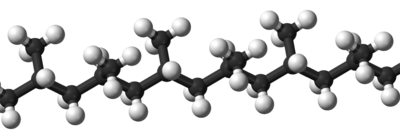| Polymer science |
|---|
 |
| Properties |
| Synthesis |
Classification
|
| Characterization |
| Scientists |
| Applications |

This article has multiple issues. Please help improve it or discuss these issues on the talk page. (Learn how and when to remove these messages)
|
Tacticity (from Greek: τακτικός, romanized: taktikos, "relating to arrangement or order") is the relative stereochemistry of adjacent chiral centers within a macromolecule. The practical significance of tacticity rests on the effects on the physical properties of the polymer. The regularity of the macromolecular structure influences the degree to which it has rigid, crystalline long range order or flexible, amorphous long range disorder. Precise knowledge of tacticity of a polymer also helps understanding at what temperature a polymer melts, how soluble it is in a solvent, as well as its mechanical properties.
A tactic macromolecule in the IUPAC definition is a macromolecule in which essentially all the configurational (repeating) units are identical. In a hydrocarbon macromolecule with all carbon atoms making up the backbone in a tetrahedral molecular geometry, the zigzag backbone is in the paper plane with the substituents either sticking out of the paper or retreating into the paper;, this projection is called the Natta projection after Giulio Natta. Tacticity is particularly significant in vinyl polymers of the type -H
2C-CH(R)- where each repeating unit with a substituent R on one side of the polymer backbone is followed by the next repeating unit with the substituent on the same side as the previous one, the other side as the previous one or positioned randomly with respect to the previous one., Monotactic macromolecules have one stereoisomeric atom per repeat unit, ditactic to n-tactic macromolecules have more than one stereoisomeric atom per unit.
The orderliness of the succession of configurational repeating units in
the main chain of a regular macromolecule, a regular oligomer molecule,
a regular block, or a regular chain.
Describing tacticity





Diads
Two adjacent structural units in a polymer molecule constitute a diad. Diads overlap: each structural unit is considered part of two diads, one diad with each neighbor. If a diad consists of two identically oriented units, the diad is called an m diad (formerly meso diad, as in a meso compound, now proscribed). If a diad consists of units oriented in opposition, the diad is called an r diad (formerly racemo diad, as in a racemic compound, now proscribed). In the case of vinyl polymer molecules, an m diad is one in which the substituents are oriented on the same side of the polymer backbone: in the Natta projection, they both point into the plane or both point out of the plane.
Triads
The stereochemistry of macromolecules can be defined even more precisely with the introduction of triads. An isotactic triad (mm) is made up of two adjacent m diads, a syndiotactic triad (also spelled syndyotactic) (rr) consists of two adjacent r diads, and a heterotactic triad (rm) is composed of an r diad adjacent to an m diad. The mass fraction of isotactic (mm) triads is a common quantitative measure of tacticity.
When the stereochemistry of a macromolecule is considered to be a Bernoulli process, the triad composition can be calculated from the probability Pm of a diad being m type. For example, when this probability is 0.25 then the probability of finding:
- an isotactic triad is Pm, or 0.0625
- an heterotactic triad is 2Pm(1–Pm), or 0.375
- a syndiotactic triad is (1–Pm), or 0.5625
with a total probability of 1. Similar relationships with diads exist for tetrads.
Tetrads, pentads, etc.
The definition of tetrads and pentads introduce further sophistication and precision to defining tacticity, especially when information on long-range ordering is desirable. Tacticity measurements obtained by carbon-13 NMR are typically expressed in terms of the relative abundance of various pentads within the polymer molecule, e.g. mmmm, mrrm.
Other conventions for quantifying tacticity
The primary convention for expressing tacticity is in terms of the relative weight fraction of triad or higher-order components, as described above. An alternative expression for tacticity is the average length of m and r sequences within the polymer molecule. The average m-sequence length may be approximated from the relative abundance of pentads as follows:
Polymers

Isotactic polymers
Isotactic polymers are composed of isotactic macromolecules (IUPAC definition). In isotactic macromolecules all the substituents are located on the same side of the macromolecular backbone. An isotactic macromolecule consists of 100% m diads, though IUPAC also allows the term for macromolecules with at least 95% m diads if that looser usage is explained. Polypropylene formed by Ziegler–Natta catalysis is an example isotactic polymer. Isotactic polymers are usually semicrystalline and often form a helix configuration.
Syndiotactic polymers
In syndiotactic or syntactic macromolecules the substituents have alternate positions along the chain. The macromolecule comprises 100% r diads, though IUPAC also allows the term for macromolecules with at least 95% r diads if that looser usage is explained. Syndiotactic polystyrene, made by metallocene catalysis polymerization, is crystalline with a melting point of 161 °C. Gutta percha is also an example syndiotactic polymer.
Atactic polymers
| This section needs additional citations for verification. Please help improve this article by adding citations to reliable sources in this section. Unsourced material may be challenged and removed. (December 2024) (Learn how and when to remove this message) |
In atactic macromolecules the substituents are placed randomly along the chain. The percentage of m diads is understood to be between 45 and 55% unless otherwise specified, but it could be any value other than 0 or 100% if that usage is clarified. With the aid of spectroscopic techniques such as NMR, it is possible to pinpoint the composition of a polymer in terms of the percentages for each triad.
Polymers that are formed by free-radical mechanisms such as polyvinyl chloride are usually atactic. Due to their random nature atactic polymers are usually amorphous. In hemi-isotactic macromolecules every other repeat unit has a random substituent.
Atactic polymers such as polystyrene (PS) are technologically very important. If a special catalyst is used in its synthesis, it is possible to obtain the syndiotactic version of this polymer, but most industrial polystyrene produced is atactic. The two materials have very different properties because the irregular structure of the atactic version makes it impossible for the polymer chains to stack in a regular fashion: whereas syndiotactic PS is a semicrystalline material, the more common atactic version cannot crystallize and forms a glass instead. This example is quite general in that many polymers of economic importance are atactic glass formers.
Eutactic polymers
In eutactic macromolecules, substituents may occupy any specific (but potentially complex) sequence of positions along the chain. Isotactic and syndiotactic polymers are instances of the more general class of eutactic polymers, which also includes heterogeneous macromolecules in which the sequence consists of substituents of different kinds (for example, the side-chains in proteins and the bases in nucleic acids).
Head/tail configuration
| This section does not cite any sources. Please help improve this section by adding citations to reliable sources. Unsourced material may be challenged and removed. (December 2024) (Learn how and when to remove this message) |

In vinyl polymers the complete configuration can be further described by defining polymer head/tail configuration. In a regular macromolecule all monomer units are normally linked in a head to tail configuration so that all β-substituents are separated by three carbon atoms. In head to head configuration this separation is only by two carbon atoms and the separation with tail to tail configuration is by four atoms. Head/tail configurations are not part of polymer tacticity but should be taken into account when considering polymer defects.
Techniques for measuring tacticity
Tacticity may be measured directly using proton or carbon-13 NMR. This technique enables quantification of the tacticity distribution by comparison of peak areas or integral ranges corresponding to known diads (r, m), triads (mm, rm+mr, rr) and/or higher order n-ads, depending on spectral resolution. In cases of limited resolution, stochastic methods such as Bernoullian or Markovian analysis may also be used to fit the distribution and predict higher n-ads and calculate the isotacticity of the polymer to the desired level.
Other techniques sensitive to tacticity include x-ray powder diffraction, secondary ion mass spectrometry (SIMS), vibrational spectroscopy (FTIR) and especially two-dimensional techniques. Tacticity may also be inferred by measuring another physical property, such as melting temperature, when the relationship between tacticity and that property is well-established.
References
- Introduction to polymers R.J. Young ISBN 0-412-22170-5
- Jenkins, A. D.; Kratochvíl, P.; Stepto, R. F. T.; Suter, U. W. (1996). "Glossary of basic terms in polymer science (IUPAC Recommendations 1996)" (PDF). Pure and Applied Chemistry. 68 (12): 2287–2311. doi:10.1351/pac199668122287. S2CID 98774337. Archived from the original (PDF) on 2016-03-04. Retrieved 2013-07-25.
- ^ Fellows, Christopher M.; Hellwich, Karl-Heinz; Meille, Stefano V.; Moad, Graeme; Nakano, Tamaki; Vert, Michel (2020). "Definitions and notations relating to tactic polymers (IUPAC Recommendations 2020)". Pure and Applied Chemistry. 92 (11): 1769–1779. doi:10.1515/pac-2019-0409. hdl:11311/1163218.
- Webster's Third New International Dictionary of the English Language, Unabridged; Oxford English Dictionary.
- Bovey, F. A. (1967). "Configurational Sequence Studies by N.M.R. And the Mechanism of Vinyl Polymerisation" (PDF). Pure and Applied Chemistry. 15 (3–4): 349–368. doi:10.1351/pac196715030349. S2CID 59059402.
- Paukkeri, R; Vaananen, T; Lehtinen, A (1993). "Microstructural analysis of polypropylenes produced with heterogeneous Ziegler–Natta catalysts". Polymer. 34 (12): 2488. doi:10.1016/0032-3861(93)90577-W.
- IUPAC macromolecular glossary Archived 2008-02-11 at the Wayback Machine
- Stevens, P. S. Polymer Chemistry: An Introduction, 3rd ed.; Oxford Press: New York, 1999; pp 234-235
- Brandrup, Immergut, Grulke (Editors), Polymer Handbook 4th edition, Wiley-Interscience, New York, 1999. VI/11
- Noble, Benjamin Brock (August 2016). Towards Stereocontrol in Radical Polymerization (PDF) (Thesis). Australian National University. doi:10.25911/5d723e5a7c412. S2CID 98943399. Archived from the original (PDF) on 2019-07-14. Retrieved 2019-07-13.
- Wu, Ting Kai; Sheer, M. Lana (1977). "Carbon-13 NMR Determination of Pentad Tacticity of Poly(vinyl alcohol)". Macromolecules. 10 (3): 529. Bibcode:1977MaMol..10..529W. doi:10.1021/ma60057a006.
- Vanden Eynde, X.; Weng, L. T.; Bertrand, P. (1997). "Influence of Tacticity on Polymer Surfaces Studiedby ToF-SIMS". Surface and Interface Analysis. 25: 41–45. doi:10.1002/(SICI)1096-9918(199701)25:1<41::AID-SIA211>3.0.CO;2-T.
- Dybal, J.; Krimm, S. (1990). "Normal-mode analysis of infrared and Raman spectra of crystalline isotactic poly(methyl methacrylate)". Macromolecules. 23 (5): 1301. Bibcode:1990MaMol..23.1301D. doi:10.1021/ma00207a013.
- Schilling, Frederic C.; Bovey, Frank A.; Bruch, Martha D.; Kozlowski, Sharon A. (1985). "Observation of the stereochemical configuration of poly(methyl methacrylate) by proton two-dimensional J-correlated and NOE-correlated NMR spectroscopy". Macromolecules. 18 (7): 1418. Bibcode:1985MaMol..18.1418S. doi:10.1021/ma00149a011.
- Gitsas, A.; Floudas, G. (2008). "Pressure Dependence of the Glass Transition in Atactic and Isotactic Polypropylene". Macromolecules. 41 (23): 9423. Bibcode:2008MaMol..41.9423G. doi:10.1021/ma8014992.
Further reading
- Wandrey, Christine (2004-04-19). "Molecular Basis of the Structure and Behavior of Polymers, Part II: Chemistry and Structure of Macromolecules—Design of Polymer Chains" (PDF). EPFL.ch (polymer chemistry course materils). Lausanne, Switzerland: Laboratory of Polymers and Biomaterials, Dept. of Chemistry, Ecole Polytechnique Federale de Lausanne (EPFL). Archived from the original (PDF) on 2004-04-19.





